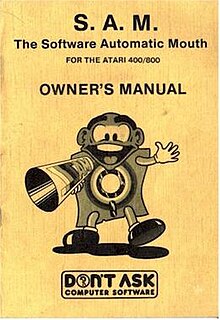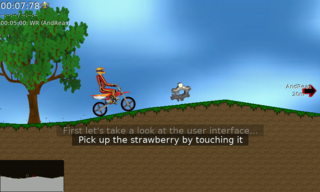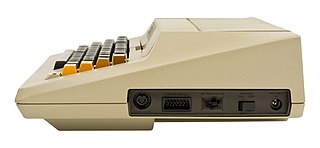
The Atari ST is a line of home computers from Atari Corporation and the successor to the Atari 8-bit family. The initial ST model, the 520ST, saw limited release in April–June 1985 and was widely available in July. The Atari ST is the first personal computer to come with a bitmapped color GUI, using a version of Digital Research's GEM released in February 1985. The 1040ST, released in 1986, is the first personal computer to ship with a megabyte of RAM in the base configuration and also the first with a cost-per-kilobyte of less than US$1.

The Atari 5200 SuperSystem, commonly known as the Atari 5200, is a home video game console that was introduced in 1982 by Atari Inc. as a higher-end complementary console for the popular Atari 2600. The 5200 was created to compete with the Intellivision, but wound up more directly competing with the ColecoVision shortly after its release.

The Atari 7800 ProSystem, or simply the Atari 7800, is a home video game console officially released by the Atari Corporation in 1986. It is almost fully backward-compatible with the Atari 2600, the first console to have backward compatibility without the use of additional modules. It was considered affordable at a price of US$140.

The Commodore 64, also known as the C64 or the CBM 64, is an 8-bit home computer introduced in January 1982 by Commodore International. It has been listed in the Guinness World Records as the highest-selling single computer model of all time, with independent estimates placing the number sold between 10 and 17 million units. Volume production started in early 1982, marketing in August for US$595. Preceded by the Commodore VIC-20 and Commodore PET, the C64 took its name from its 64 kilobytes(65,536 bytes) of RAM. With support for multicolor sprites and a custom chip for waveform generation, the C64 could create superior visuals and audio compared to systems without such custom hardware.

The Atari 8-bit family is a series of 8-bit home computers introduced by Atari, Inc. in 1979 and manufactured until 1992. All of the machines in the family are technically similar and differ primarily in packaging. They are based on the MOS Technology 6502 CPU running at 1.79 MHz, and were the first home computers designed with custom co-processor chips. This architecture enabled graphics and sound capabilities more advanced than most contemporary machines, and gaming on the platform was a major draw. The first-person space combat simulator Star Raiders is considered the platform's killer app. The systems launched with a series of plug and play peripherals that used the Atari SIO serial bus system, an early analog of USB.

Chiptune, also known as chip music, is a style of synthesized electronic music made using the programmable sound generator (PSG) sound chips or synthesizers in vintage arcade machines, computers and video game consoles. The term is commonly used to refer to tracker format music which intentionally sounds similar to older PSG-created music, as well as music that combines PSG sounds with modern musical styles. It has been described as "an interpretation of many genres" since any existing song can be arranged in a chiptune style defined more by choice of instrument and timbre than specific style elements.

Star Raiders is a first-person space combat simulator for the Atari 8-bit family of computers. It was written by Doug Neubauer, an Atari employee, and released in cartridge form by Atari in 1979. The game is commonly referred to as the platform's killer app. It was later ported to the Atari 2600, Atari 5200, and Atari ST.

The MOS Technology 6581/8580 SID is the built-in programmable sound generator chip of Commodore's CBM-II, Commodore 64, Commodore 128 and Commodore MAX Machine home computers. It was one of the first sound chips of its kind to be included in a home computer prior to the digital sound revolution.
Video game music is the soundtrack that accompanies video games. Early video game music was once limited to simple melodies of early sound synthesizer technology. These limitations inspired the style of music known as chiptunes, which combines simple melodic styles with more complex patterns or traditional music styles, and became the most popular sound of the first video games.

The Pot Keyboard Integrated Circuit (POKEY) is a digital I/O chip designed for the Atari 8-bit family of home computers and found in Atari arcade games of the 1980s. POKEY combines functions for sampling (ADC) potentiometers and scan matrices of switches as well as sound generation. It produces four voices of distinctive square wave sound, either as clear tones or modified with a number of distortion settings. POKEY chips are used for audio in many arcade games including Centipede, Missile Command, Asteroids Deluxe, and Gauntlet. Some of Atari's arcade systems use multi-core versions with 2 or 4 POKEY chips in a single package for more sound voices. The Atari 7800 console allows a game cartridge to contain a POKEY, providing better sound than the system's audio chip. Only two licensed games make use of this: the ports of Ballblazer and Commando.
The digital sound revolution refers to the widespread adoption of digital audio technology in the computer industry beginning in the 1980s.

The Television Interface Adaptor (TIA) is the custom computer chip that is the heart of the Atari 2600 game console, generating the screen display, sound effects, and reading input controllers. Its design was widely affected by an attempt to reduce the amount of RAM needed to operate the display. The resulting design is notoriously difficult to program, which is an ongoing challenge for developers.

Software Automatic Mouth, or S.A.M., is a speech synthesis program developed by Mark Barton and sold by Don’t Ask Software. The program was released for the Atari 8-bit family, Apple II, and Commodore 64. Released in 1982, it was one of the first commercial all-software voice-synthesis programs.
MDX is a Music Macro Language (MML) based format designed to be played on the X68000 series of computers. The music data is programmed then compiled into the MDX file. An optional PDX file containing PCM data may be present.

ProTracker is a music tracker for the Amiga platform. A free software tool that required no additional equipment, it became popular in the early 1990s with both amateurs and professionals, allowing for sample-based music in the MOD file format.
Atari System refers to two arcade system boards introduced in 1984 for use in various arcade games from Atari Games. Two versions of the board were released, Atari System 1 and Atari System 2.

X-Moto is a free and open source 2D motocross platform game developed for Linux, FreeBSD, Mac OS X and Microsoft Windows, where physics play an all important role in the gameplay. The basic gameplay clones that of Elasto Mania, but the simulated physics are subtly different.

The Serial Input/Output system, universally known as SIO, was a proprietary peripheral bus and related software protocol stacks used on the Atari 8-bit family to provide most input/output duties for those computers. Unlike most I/O systems of the era, such as RS-232, SIO included a lightweight protocol that allowed multiple devices to be attached to a single daisy-chained port that supported dozens of devices. It also supported plug-and-play operations. SIO's designer, Joe Decuir, credits his work on the system as the basis of USB.
Doug Neubauer is an American integrated circuit designer, video game designer, and programmer best known for the logic design on Atari's POKEY chip and designing and programming the 1979 video game Star Raiders which became the killer app for the Atari 8-bit family.

Sierra was the code name for a 16-bit/32-bit personal computer designed by the Sunnyvale Research Lab (SRL) of Atari, Inc. starting around 1983. The design was one of several new 16-bit computer systems proposing to use a new chipset from Atari Corporate Research. The graphics portion consisted of a two chip system called "Silver and Gold", Gold was the graphics display processor and Silver was a sprite processor. The audio portion of the chipset consisted of a powerful sound synthesizer known as AMY. Several proposed operating systems were considered was a VisiCorps VISI ON and Atari's own internal OS code named "Snowcap." The chipset was collectively known as Rainbow, and the system is sometimes referred to by this name. The CPU had not been chosen, but the Motorola 68000, National Semiconductor 32016 and Intel 286 were being considered.













